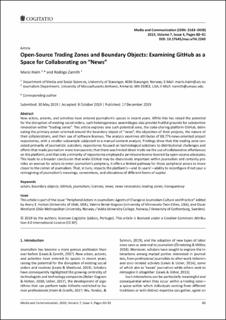| dc.contributor.author | Haim, Mario | |
| dc.contributor.author | Zamith, Rodrigo | |
| dc.date.accessioned | 2020-05-06T13:55:09Z | |
| dc.date.available | 2020-05-06T13:55:09Z | |
| dc.date.created | 2019-10-11T11:03:01Z | |
| dc.date.issued | 2019-12 | |
| dc.identifier.citation | Haim, M., Zamith, R. (2019) Open-Source Trading Zones and Boundary Objects: Examining GitHub as a space for collaborating on "news". Media and Communication, 7 (4), pp. 80-91. | en_US |
| dc.identifier.issn | 2183-2439 | |
| dc.identifier.uri | https://hdl.handle.net/11250/2653533 | |
| dc.description.abstract | New actors, actants, and activities have entered journalism’s spaces in recent years. While this has raised the potential for the disruption of existing social orders, such heterogeneous assemblages also provide fruitful grounds for substantive innovation within “trading zones.” This article explores one such potential zone, the code-sharing platform GitHub, delineating the primary actors oriented around the boundary object of “news,” the objectives of their projects, the nature of their collaborations, and their use of software licenses. The analysis examines attributes of 88,776 news-oriented project repositories, with a smaller subsample subjected to a manual content analysis. Findings show that this trading zone consisted primarily of journalistic outsiders; repositories focused on technological solutions to distributional challenges and efforts that made journalism more transparent; that there was limited direct trade via the use of collaborative affordances on the platform; and that only a minority of repositories employed a permissive license favored by open-source advocates. This leads to a broader conclusion that while GitHub may be discursively important within journalism and certainly provides an avenue for actors to enter journalism’s periphery, it offers a limited pathway for those peripheral actors to move closer to the center of journalism. That, in turn, impacts the platform’s—and its users’—ability to reconfigure if not spur a reimagining of journalism’s meanings, conventions, and allocations of different forms of capital. | en_US |
| dc.language.iso | eng | en_US |
| dc.publisher | Cogitatio | en_US |
| dc.rights | Navngivelse 4.0 Internasjonal | * |
| dc.rights.uri | http://creativecommons.org/licenses/by/4.0/deed.no | * |
| dc.subject | GitHub | en_US |
| dc.subject | nyheter | en_US |
| dc.subject | journalistikk | en_US |
| dc.title | Open-Source Trading Zones and Boundary Objects: Examining GitHub as a space for collaborating on "news" | en_US |
| dc.type | Peer reviewed | en_US |
| dc.type | Journal article | en_US |
| dc.description.version | publishedVersion | en_US |
| dc.rights.holder | © Mario Haim, Rodrigo Zamith. | en_US |
| dc.subject.nsi | VDP::Samfunnsvitenskap: 200::Medievitenskap og journalistikk: 310 | en_US |
| dc.source.pagenumber | 80-91 | en_US |
| dc.source.volume | 7 | en_US |
| dc.source.journal | Media and Communication | en_US |
| dc.source.issue | 4 | en_US |
| dc.identifier.doi | 10.17645/mac.v7i4.2249 | |
| dc.identifier.cristin | 1736350 | |
| cristin.ispublished | true | |
| cristin.fulltext | original | |
| cristin.qualitycode | 1 | |

